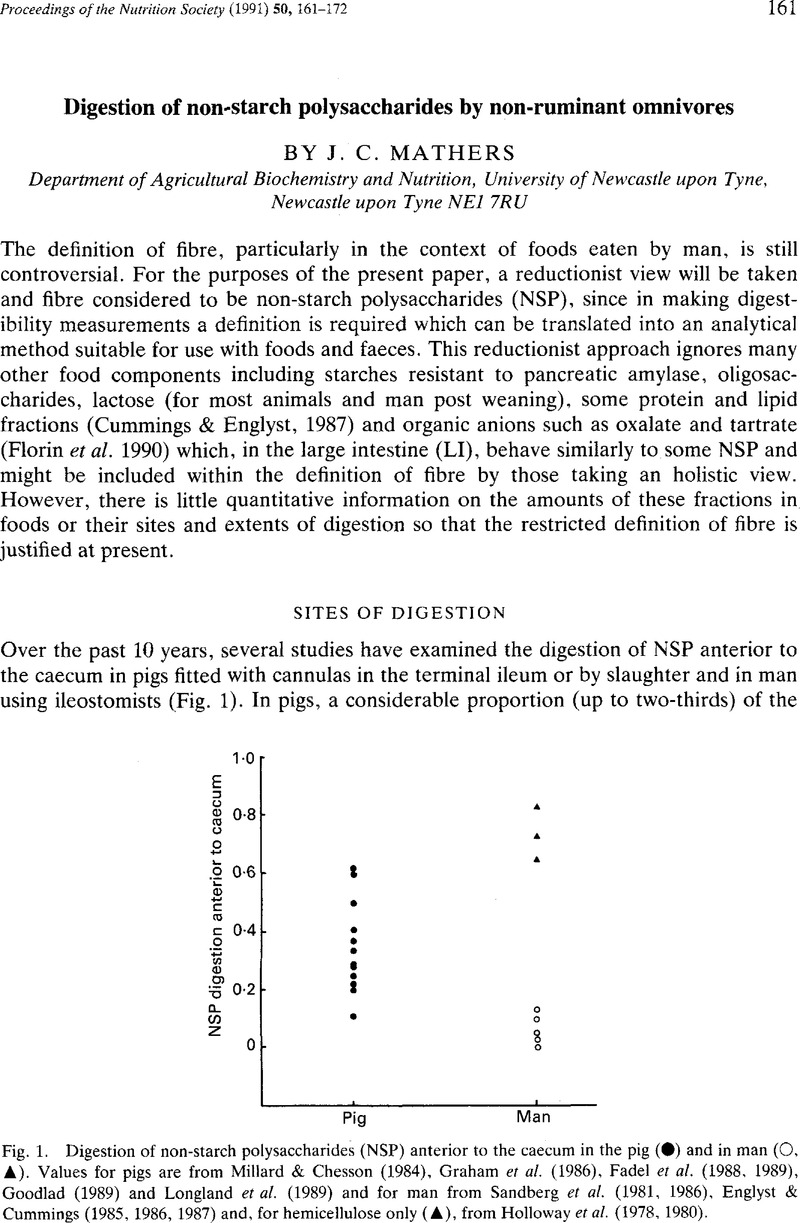Crossref Citations
This article has been cited by the following publications. This list is generated based on data provided by Crossref.
1991.
Abstracts of Communications.
Proceedings of the Nutrition Society,
Vol. 50,
Issue. 3,
p.
176A.
Livesey, G.
1992.
The Energy Values of Dietary Fibre and Sugar Alcohols for Man.
Nutrition Research Reviews,
Vol. 5,
Issue. 1,
p.
61.
Goodlad, J. S.
and
Mathers, J. C.
1992.
Digestion of complex carbohydrates and large bowel fermentation in rats fed on raw and cooked peas (Pisum sativum).
British Journal of Nutrition,
Vol. 67,
Issue. 3,
p.
475.
D�sterh�ft, E. -M.
Bonte, A. W.
Venekamp, J. C.
and
Voragen, A. G. J.
1993.
The role of fungal polysaccharidases in the hydrolysis of cell wall materials from sunflower and palm-kernel meals.
World Journal of Microbiology & Biotechnology,
Vol. 9,
Issue. 5,
p.
544.
Knudsen, Knud Erik Bach
Jensen, Bent Borg
and
Hansen, Inge
1993.
Digestion of polysaccharides and other major components in the small and large intestine of pigs fed on diets consisting of oat fractions rich in β-D-glucan.
British Journal of Nutrition,
Vol. 70,
Issue. 2,
p.
537.
Livesey, Geoffrey
1993.
Comments on the methods used to determine the energy values of carbohydrates: Dietary fibre, sugar alcohols and other bulking agents.
International Journal of Food Sciences and Nutrition,
Vol. 44,
Issue. 4,
p.
221.
Mathers, J. C.
Kennard, Julia
and
James, O. F. W.
1993.
Gastrointestinal responses to oats consumption in young adult and elderly rats: digestion, large bowel fermentation and crypt cell proliferation rates.
British Journal of Nutrition,
Vol. 70,
Issue. 2,
p.
567.
Key, Fiona B.
and
Mathers, J. C.
1993.
Gastrointestinal responses of rats fed on white and wholemeal breads: complex carbohydrate digestibility and the influence of dietary fat content.
British Journal of Nutrition,
Vol. 69,
Issue. 2,
p.
481.
Mathers, J. C.
and
Tagny, J.-M. Fotso
1994.
Diurnal changes in large-bowel metabolism: short-chain fatty acids and transit time in rats fed on wheat bran.
British Journal of Nutrition,
Vol. 71,
Issue. 2,
p.
209.
Raben, A
Tagliabue, A
Christensen, NJ
Madsen, J
Holst, JJ
and
Astrup, A
1994.
Resistant starch: the effect on postprandial glycemia, hormonal response, and satiety.
The American Journal of Clinical Nutrition,
Vol. 60,
Issue. 4,
p.
544.
Key, Fiona B.
and
Mathers, J. C.
1995.
Digestive adaptations of rats given white bread and cooked haricot beans (Phaseolus vulgaris): Large-bowel fermentation and digestion of complex carbohydrates.
British Journal of Nutrition,
Vol. 74,
Issue. 3,
p.
393.
Raben, Anne
TAGLIABUE, ANNA
and
Astrup, Arne
1995.
The reproducibility of subjective appetite scores.
British Journal of Nutrition,
Vol. 73,
Issue. 4,
p.
517.
Champ, M.
and
Faisant, N.
1996.
Carbohydrates as Organic Raw Materials III.
p.
189.
Jamroz, D.
Eder, K.
Wiliczkiewicz, A.
and
Kirchgessner, M.
1998.
Verdaulichkeit der NSP‐gebundenen Zucker bei Verfütterung von Triticale und Enzymen an Hähnchen, Enten und Gänse.
Journal of Animal Physiology and Animal Nutrition,
Vol. 79,
Issue. 1-5,
p.
113.
Phillips, Glyn O.
1998.
Acacia gum (Gum Arabic): A nutritional fibre; metabolism and calorific value.
Food Additives and Contaminants,
Vol. 15,
Issue. 3,
p.
251.
Gidenne, Thierry
and
Bellier, Rachel
2000.
Use of digestible fibre in replacement to available carbohydrates.
Livestock Production Science,
Vol. 63,
Issue. 2,
p.
141.
Carabaño, R.
García, J.
and
Blas, J. C. de
2001.
Effect of fibre source on ileal apparent digestibility of non-starch polysaccharides in rabbits.
Animal Science,
Vol. 72,
Issue. 2,
p.
343.
Seal, C. J.
and
Mathers, J. C.
2001.
Comparative gastrointestinal and plasma cholesterol responses of rats fed on cholesterol-free diets supplemented with guar gum and sodium alginate.
British Journal of Nutrition,
Vol. 85,
Issue. 3,
p.
317.
Martín-Orúe, Susana M.
O'Donnell, Anthony G.
Ariño, Joaquin
Netherwood, Trudy
Gilbert, Harry J.
and
Mathers, John C.
2002.
Degradation of transgenic DNA from genetically modified soya and maize in human intestinal simulations.
British Journal of Nutrition,
Vol. 87,
Issue. 6,
p.
533.
Rubio, Luis A
Muzquiz, Mercedes
Burbano, Carmen
Cuadrado, Carmen
and
Pedrosa, Mercedes M
2002.
High apparent ileal digestibility of amino acids in raw and germinated faba bean (Vicia faba)‐ and chickpea (Cicer arietinum)‐based diets for rats.
Journal of the Science of Food and Agriculture,
Vol. 82,
Issue. 14,
p.
1710.



